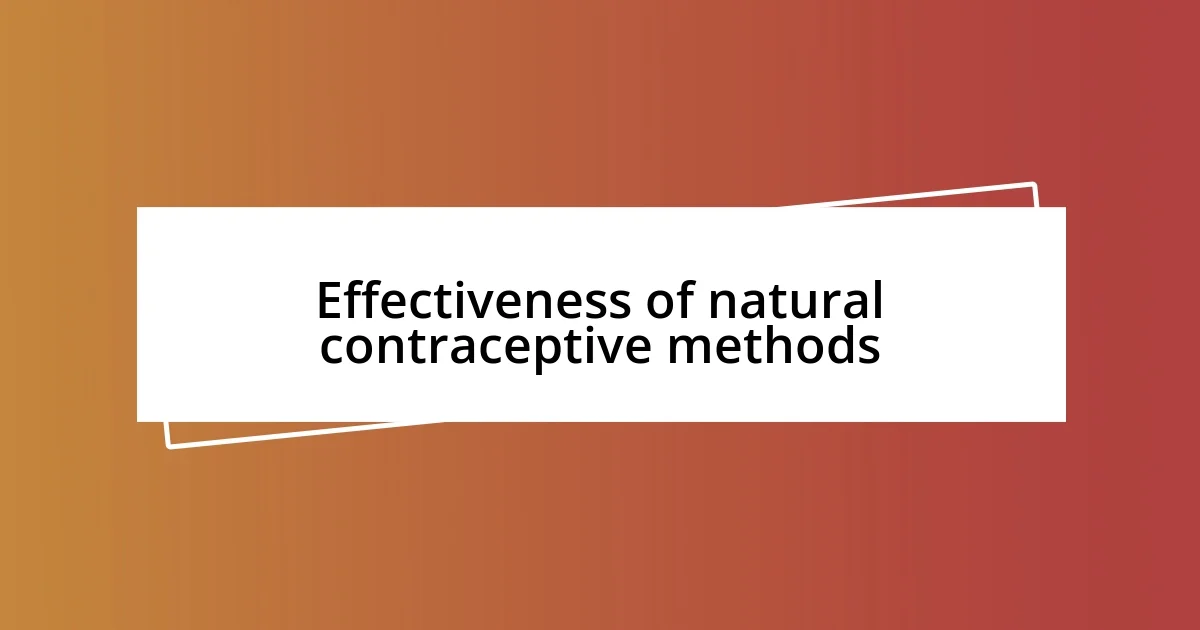Key takeaways:
- Natural contraceptive methods rely on understanding the body’s cycles, fostering self-awareness and informed reproductive choices.
- Key benefits include health awareness, lack of side effects, cost-effectiveness, and improved couple communication.
- Effectiveness varies based on personal commitment and factors like stress; consistency, communication, and patience are essential for success.

Understanding natural contraceptive methods
Natural contraceptive methods revolve around understanding your body’s cycles and rhythms. I remember when I first learned about fertility awareness; it was like unlocking a secret map of my own biology. It’s fascinating how our bodies signal fertility through physical signs—doesn’t that just make you feel more connected to yourself?
Tracking menstrual cycles, observing cervical mucus, and monitoring basal body temperature are core to these methods. I found that using a simple app to chart my cycle not only helped me understand my fertility but also deepened my appreciation for the natural processes at play. Have you ever noticed how your body communicates with you? It’s truly eye-opening.
These approaches require commitment and education but can be incredibly empowering. I often think about the balance they offer—not just a means of contraception, but a way to engage holistically with one’s health. It’s about being in tune with oneself, don’t you think?

Benefits of natural contraceptive methods
Natural contraceptive methods offer some unique advantages that resonate deeply with those looking for alternatives to hormonal options. Personally, I’ve found that these methods foster a sense of empowerment. It’s incredible how understanding my own body can lead to more informed choices—it’s like taking the reins on my reproductive health.
Here’s a quick look at some key benefits:
- Health Awareness: Being attuned to my body helps me identify any irregularities.
- No Side Effects: Unlike hormonal contraception, I experienced fewer mood swings and no weight gain.
- Cost-Effective: Many natural methods require no purchase or low-cost tools, making them budget-friendly.
- Sustainability: Natural methods often have a minimal environmental footprint, aligning with eco-conscious values.
- Couples Connection: Practicing these methods together with my partner has strengthened our communication and trust.
When I first shifted to natural methods, I was pleasantly surprised by how much I learned from simply paying attention to my cycles. It not only made me more mindful about my health but also enriched my relationship with my partner—talk about a win-win!

Common types of natural contraceptive methods
Common types of natural contraceptive methods vary based on personal preferences and lifestyles. One of the most well-known approaches is the fertility awareness method (FAM), which involves tracking your menstrual cycle to identify fertile days. I recall when I began charting my fertility signs; at first, it seemed daunting. However, seeing patterns emerge over the months was truly enlightening, almost like piecing together a puzzle about my own body.
Another popular method is the withdrawal method, or “pulling out,” where the male partner withdraws before ejaculation. While this method has been used for centuries, I’ve found that it requires a significant amount of trust and communication. It definitely encouraged my partner and me to have more open discussions about our desires and boundaries, which brought us closer together.
Lastly, there’s the Cervical Mucus Method, which helps you monitor changes in your mucus throughout your cycle. As I started paying attention to this subtle body signal, I was surprised at how informative it was. It took some practice to recognize the different textures and colors, but once I did, it felt empowering to understand my body’s natural signs of fertility better.
| Method | Key Characteristics |
|---|---|
| Fertility Awareness Method (FAM) | Tracking menstrual cycles, predicting ovulation |
| Withdrawal Method | Timing withdrawal before ejaculation |
| Cervical Mucus Method | Monitoring changes in cervical mucus for fertility signs |

Effectiveness of natural contraceptive methods
Understanding the effectiveness of natural contraceptive methods can be a bit of a mixed bag. When I first started with the fertility awareness method, I did my research and came across various statistics. They suggest that with perfect use, FAM can be about 99% effective. That’s impressive, right? However, I quickly realized that “perfect” also means being diligent and consistent. Life gets busy, and any hiccup in tracking can decrease its effectiveness significantly.
Then there’s the withdrawal method, which many people have relied on for years. Personally, I had my doubts about it. In my experience, even with the best intentions, it requires great timing and mutual understanding. I’ve found that while it can be effective, it’s not foolproof—statistics show a failure rate of about 22% with typical use. Those numbers always made me wonder: how realistic is it to expect perfection when intimacy is involved? This method definitely requires honest conversations between partners, which can sometimes be challenging.
Finally, the monitoring of cervical mucus has its own level of reliability. I have to admit, at first, I was skeptical about how much insight a natural bodily fluid could provide. But as I honed my observation skills, I discovered that recognizing my body’s signals became quite intuitive. Some research indicates that users can have a 97% effectiveness rate if they track mucus changes diligently. It’s fascinating how paying close attention truly empowers you; it was like tuning into a secret language that my body was speaking all along. Do you see how these methods can vary in effectiveness based on personal commitment?

Best practices for using natural contraceptive methods
To maximize the effectiveness of natural contraceptive methods, consistency is key. I learned this firsthand when I kept a dedicated journal to track my fertility signals. It became a kind of personal ritual, and the more committed I was, the clearer the patterns became. Have you tried integrating such a routine? It truly transformed how I understood my cycle.
Open communication with your partner is another crucial practice. During my journey, I often found it challenging to discuss our methods and boundaries, but those conversations significantly deepened our connection. Once we started sharing our thoughts and concerns openly, the whole experience became more collaborative and reassuring. I’d encourage anyone using these methods to take that leap—how else can you ensure both partners feel comfortable and confident?
Lastly, I recommend being patient with yourself and the learning process. I remember feeling frustrated when I couldn’t predict my fertile days perfectly. But as time went on, I realized that like any new skill, it requires practice. Have you ever felt that initial struggle before mastering something? Embracing the learning curve can lead to great empowerment as you gain deeper insights into your body’s unique rhythms.

Potential risks of natural contraceptive methods
When discussing the potential risks of natural contraceptive methods, it’s important to consider the uncertainty that comes with them. I remember a time when I thought I had my cycle all figured out, only to face an unexpected twist. I had miscalculated my fertile window, which led to a moment of panic. Has this ever happened to you? It highlighted just how easily things can go awry when relying solely on natural signals without a backup.
Another risk lies in the emotional strain that these methods can place on relationships. I recall a particularly intense discussion with my partner about our contraceptive choices. The pressure of timing and tracking can sometimes lead to frustration, especially when one partner feels they’re carrying more of the responsibility. How do you balance your needs with your partner’s? Finding that middle ground can be challenging, and if not addressed, it can affect intimacy and trust.
Furthermore, there’s the inherent challenge of external factors impacting the accuracy of natural methods. Stress, travel, and health changes can interfere with your body’s signals. I once faced this myself after a particularly stressful week at work, where my cycle seemed completely off. It made me wonder: are we truly in tune with our bodies, or just hoping for the best? Acknowledging these external impacts is essential for anyone considering natural contraception, as they can lead to unintended consequences if not carefully managed.

Conclusion on natural contraceptive methods
Natural contraceptive methods offer a fascinating blend of self-awareness and shared responsibility. Reflecting on my experience, I found them empowering yet sometimes unpredictable. Have you ever felt a mix of excitement and apprehension about taking control over your reproductive choices? For me, the journey was a bittersweet reminder that while understanding my body brought clarity, there were still moments of uncertainty that tested my confidence.
It’s essential to recognize that these methods aren’t a one-size-fits-all solution. I remember chatting with a friend who struggled with irregular cycles; her journey with natural methods often felt daunting. How do we navigate such differences in our experiences? It emphasizes the importance of customizing our approach to suit personal health needs and lifestyle, rather than strictly adhering to generalized strategies.
Lastly, embracing natural contraceptive methods means developing a nuanced relationship with your body. I often found solace in knowing my cycle better, despite the occasional misstep. Does that resonate with you? The lessons learned—patience, observation, and communication—were invaluable. In the end, it’s about finding what truly works for you and your partner, fostering a sense of unity and shared understanding as you navigate this process together.













